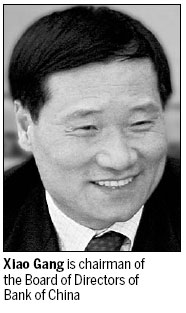Opinion
Don't blame it on the govt
By Xiao Gang (China Daily)
Updated: 2010-08-25 15:24
 |
Large Medium Small |
The figures for new yuan loans made by Chinese banks in July represented a slowdown from June. In the first seven months of this year, new loans reached 5.16 trillion yuan ($759.06 billion), compared with 7.73 trillion yuan during the same period last year.
Many people have reason to believe that China's lending spree last year - which saw a record new loan volume of nearly 10 trillion yuan and regarded as part of the massive stimulation package to boost the economy - was the result of the government's intervention. The evidence seems obvious - the government holds controlling stakes in those banks and appoints their chairpersons and CEOs. Naturally, the banks became the government's cash machine.
Although this argument seems reasonable on the surface, it is far from the truth. 
Since the major State-owned banks have undergone a process of commercialization, from financial restructuring to forming foreign strategic partnerships to going public, they have generated a strong internal and market-driven desire to increase their lending. They did not act on government orders.
As a matter of fact, the banks had strong incentives to rapidly grow their loan portfolios before the global financial crisis, but financial regulators had imposed an annual limit on the maximum amount of new loans each could issue. Thanks to such an administrative measure potential lending had been temporarily curbed. During the crisis, the government-led stimulus package created a window of opportunity, which the banks had been waiting for years. Part of this included lifting the cap on bank lending.
Profit is the main driving force of banks. Listed banks have shareholders and must pay attention to market value. Money must be made each quarter and each year to improve certain key performance indices, such as return on equity and return on assets. Like listed banks anywhere in the world, these banks must catch the eyes of new investors, and increase returns to existing ones.
In China, because of the non-liberalized interest rate, net interest margins on yuan loans are almost double of that on foreign currency loans in the international market. In such an environment, which bank wouldn't want to increase its lending? The more banks lend, the more profits they earn. Simple.
Interestingly, the banks have revamped the remuneration schemes top-down, closely linking their employees' emoluments and branches' expenses to performance, in particular, to revenues and profits. The emoluments usually consist of two parts: one is the basic wage related to different posts, and the other is performance-linked bonus that generally accounts for 50-70 percent of the total emoluments. Those who do not advocate issuing more loans (and therefore make more profits) are, of course, not so popular within banking circles.
While expanding their loan portfolios, Chinese banks are smart enough to take the risk-averse approach and to focus on lending to large State-owned enterprises (SOEs). These SOEs often enjoy monopoly in their sectors and quasi-government credit ratings. This can, in turn, explain why Chinese banks have steadily improved their asset quality and reduced their non-performing asset ratios.
In recent years, the banks have also boosted their small- and medium-sized enterprises (SMEs) finance business under the government's guidance and encouragement. This area allows an even wider net-interest margin, but SME loans account for a relatively small proportion of their total assets. The banks are fully aware of the risks of granting loans to SMEs, which are more than often than not short-lived (more than 60 percent of the SMEs have a life cycle of less than 5 years) and often lack transparent financial transactions.
What's more, once an SME loan turns bad, the relevant bank staff are more likely to be questioned (and, perhaps, punished) than if an SOE defaults on its loan payments. Often such questioning is accompanied by suspicions of corruption and under-the-table dealings.
Competition plays its part in increasing loan amounts. More transparency and regulatory discipline require the banks to disclose their financial statements on a quarterly basis, and the financial regulators want to obtain data on new loans from all the banks daily. Banks then voluntarily exchange such information with each other, and this mechanism leads to comparisons among the banks.
Every bank pays special attention to its market share and league table position almost daily, so inter-bank competition is constant and intense. This "herd" effect has sometimes dominated the banking business and has influenced the banks' behavior, which could have contributed to the irrational expansion of their business.
Critics argue that its the Party committee in the banks that decided to increase the loan size. Many take this for granted. But it is not true. All the listed banks have established, modern corporate governance. Non-executive directors, including independent directors, take up the majority of the board seats. The decision-making procedures are quite rigorous and transparent, with each member having one vote. It is impossible for the Party committee to dictate terms to the directors during voting. The banks' annual deposit, and loan plans and budgets do not come into effect until the board of directors approves them.
As a chairman of a bank, I have never received any instructions from the government to lend money to any project. All decisions relating to business were made either by the board, or by the management.
The government's active fiscal policy and loose monetary policy, without doubt, encouraged the explosion of loans. Yet blaming the lending spree on the government is easy, overly simplistic and unfair. Growing big is the best way for Chinese banks to make more money under the current financial environment. This model of growth, however, neither assures the long-term sustainable development of the banking sector nor satisfies the need of a balanced economic and social structure.
Things are very complicated, so will be the solutions.
It will be a synthesized effort on the part of the government, the regulators, enterprises, and the commercial banks.



